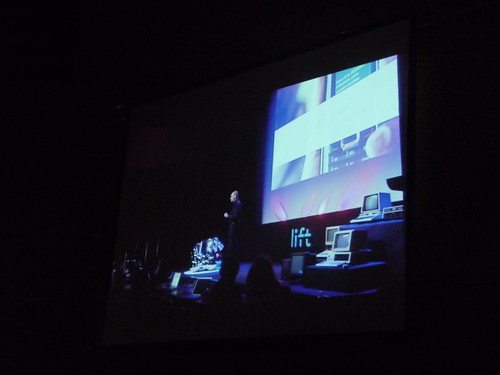In My Lift09 Doggie Bag
Posted: March 2nd, 2009 | No Comments »Back from Lift09 with my traditional doggie bag (see Lift06, Lift07, Lift08) filled with food for thoughts and unlikely take-aways (all the videos are online).
This year, I got the pleasure to moderate the “Towards a long here” session, a title inspired by Adam Greenfield’s concept of Long Here and Big Now. Carlo Ratti, Dan Hill and Anne Galloway shared their take on the challenges, problems and opportunities of the recombination of urban environments through technological advancements. First, Carlo Ratti gave a punchy rundown (fing’s notes) of the MIT SENSEable City Lab’s projects, with a nice homage to my tracing the visitor’s eyes. Each project provides an evidence that bits and atoms are coming together to reveal invisible urban dynamics (Real-time Rome, NYTE, World’s Eyes, Track Trash) and provide new types of experiences in urban space (WikiCity, Digital Water Pavilion). Without devaluating the importance of engaging visualizations of urban dynamics, Dan Hill (fing’s notes, Dan’s notes) showed evidences of the less happy marriage of soft and hard infrastructures from his frustrating 4-days journey to reach the northern hemisphere. It is when soft infrastructures “attack” (exception handling when rerouting passengers of a malfunctioning 747, lack of information system, smart card at the hotel not working) that we get the feeling of their importance (making me think to the Code/Space concepts). Bottom line: “it may not matter how good the hard infrastructure is, it is the soft infrastructure that affects how you feel“. Therefore, software infrastructures are not only about technology, it is also about software design, service design, interaction design, looking at the wider context of the organization, systems and people, urban design, urban informatics and even business models, the legal and political context, the belief systems and the social and cultural fabric. If we do not understand these aspects, we will make the same mistakes as past visions that relied on the fascination around the hard infrastructures and reducing cities to systems. When stepping back and considering the future with and understanding of why past vision never happened, it becomes clear that people (social, cultural, political such as privatization of properties) drive the evolution of cities, not technology (here I like to talk about co-evolution). Taking that into account, the exploitation of these soft infrastructure might lead to promising “super-powers” (here Matt Jones’ latest talk “The Demon-Haunted World” with the quote “the car changed the development of the city irreversibly in the 20th century. I’d claim that mobiles will do the same in the 21st” comes to mind): a) control of the transit network, not the other way around (e.g. visualization of Velib nodes revealing new movements in cities), b) ability to see the invisible activity, c) post-occupancy evaluation and feedback loops.

Dan Hill and the animated Velib nodes trick…
However the development of these “super-powers” and the improvement of the relationships between hard and soft might not come without a engaging the actors (I see using visualization as one way to stretch the imagination and engage into the action), b) user-centered design (the web industry could teach the architecture world, like the learned from product design and industrial design!), and c) Ove Arup’s “Total design” with an architecture team made of new disciplines such software engineers, interaction designers, sociologist, ethnographers, economists. Anne Galloway (fing’s notes), stepped away from a utilitarian discoursed and perfectly built on Carlo Ratti and Dan Hill’s suggestions, and the expressions of expectations, promises and hopes around these future cities and their informational membrane. If we consider the design of these cities and their positive aims as a gift (gift taken within its complex interaction): it might imply a gift back (uneven expectations), it might not be well interpreted (like any awkward gifts). So if we offer citizen better awareness of the city dynamics and power to influence the city evolution, does not mean they will accept the gift. Indeed, taking the example of citizen-science and people-centric sensing, citizen might just not be interested in the collect of the data, it might increase the divide between the people who are able to participate and the ones who don’t (as discussed in The rise of the sensor citizen).
Some speakers discussed the study of failures (Nicolas Nova) and the acknowledgment of chaos (Fabio Sergio discussed that hope and dreams carried in design only show a perfect world, a world that does not exist, and then had the necessary slide on the Napoli garbare issue) as part of the design process. It was music to my hears after talking about seamful design and mesiness at lift07.
A workshop on the design of hybrid cities of the near future also took place. More on that later…
Once again, the Lift Conference outdid itself, a conference that has the self-confidence to take chances in inviting unlikely but refreshing speakers (Baba Wamé, Frank Beau) mixed with safe bets that always deliver beyond expectation (Matt Webb, Fabio Sergio, Dan Hill, Anne Galloway…) and open stages with a smart sense of provocation like Bill Thompson’s the death of privacy or inspiration with Felix Koch and Fabian Keller on the literacy of cutting. Lift is THE conference of the World-Wide Lab, the best hybrid forum out there. There is still a need to work on the workshops formats to get back to lifto6′s level.
Once again, my hat is off to the organizers!

Fabio Sergio at Lift Conference 2009

